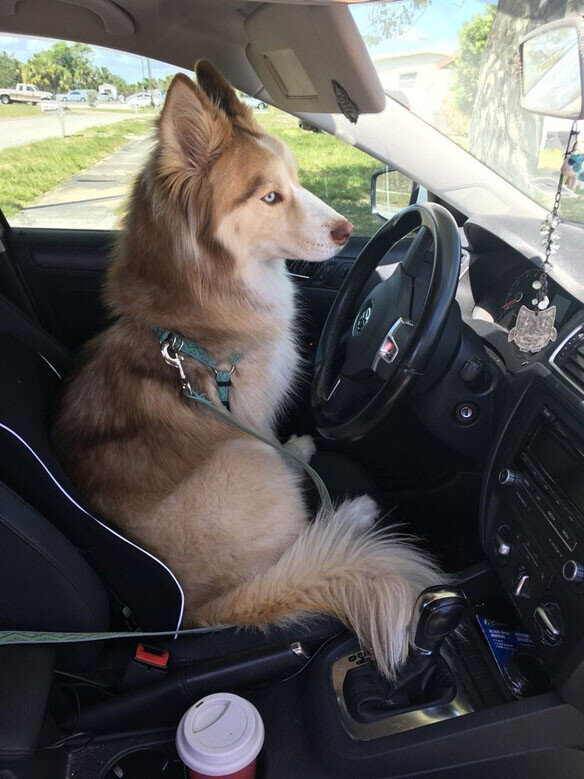
Moving can be stressful for the average human so just imagine how unsettling it could be to your pets! The challenges of moving don’t come with a win-all solution , but here are some tips that could help make the transition to your new home as smooth as possible!
General Tips:
- If you’re moving far away, try to find a new veterinarian beforehand. Remember to get copies of your pet’s current records from the vet you currently use.
- A long distance move might also require hotel stays. Plan your trip in advance and find pet-friendly hotels along the way.
- Bring any medications: If you are traveling by car be sure to have the proper medications and schedule breaks to administer them – including some time for food and water (the water should be from your previous home for familiarity).
- Choose your new home and neighborhood with your pets in mind. Make sure you’re moving to a pet-friendly area – this is especially important if you have dogs, and need a safe area to walk them! Also, choose a home that has enough living space for you and your pets. Cats will need plenty of space to climb and roam.
- During the move itself, the best way to reduce stress on an animal is to keep them in the quietest area possible.
- Move the house before you move the pet. Set up as much as you can, even just in a room, before you introduce the animal to the new home.
- Give them a few days in the new home to adjust slowly.
- After you move, make sure you update their tags or microchip information to the new address and phone number.
- While you’ll likely be very busy with all the matters of the move, don’t forget to take extra time to show affection and support for your pets. Remember, they don’t understand what’s happening! Extra play time, treats, and cuddles will go a long way in helping your pet adjust to all the changes.
- Prepare an easily-accessible ‘overnight kit’ that has enough dog food, kitty litter, toys and grooming tools to sustain your pet and keep them comfortable during the first few days of unpacking.

Tips Specifically for Cats:
- Get them properly acquainted with the Cat Carrier. Some cats really don’t like being inside of a cat carrier and aren’t afraid to express their opinions about it. If your cat falls into this category put the carrier out in an ample amount of time before your move so that your cat can warm up to the idea and isn’t shell shocked when you stuff them in there out of the blue.
- Do not open the carrier during the actual move. Regardless of your cat’s cries, do not open their carrier during the actual move for fear that they may escape. An anxiety-ridden cat roaming around a car in motion is not a good idea and can be dangerous for both cat and driver. Wait until you are in a secure area to release the cat from their carrier.
- Keep kitty in the bathroom during the move. To ensure that your cat doesn’t make a dash out the door keep them contained inside of a bathroom with food, water, and litter available. Cats may become very skittish with so much foot traffic coming in and out of the home while people are moving belongings or furniture in and out. It’s always a good idea to leave a sign on the door to warn others of the precious cargo inside the bathroom that you don’t want escaping.
- Be sure to cat proof your new home. With a new home comes new things and it’s smarter to play things safe than sorry. Check the electrical outlets, any possibility for poisonous house plants, and screen checks for all the windows.
- If you’re flying to your new home. Make sure your cat is in an airline-approved carrier and always fly with kitty in the cabin of the plane with you – it’s much safer than shipping your cat as cargo!
- Before you let your cat out to explore the new digs, make sure you inspect your home for potential problems. Make sure all windows are closed or window screens are tightly in place to avoid an escapee. Make sure the cords on your blinds or curtains are safely out of reach. And, be careful that anything that might be a potential hazard for your curious kitty is put away – like any cleaning supplies.
- Letting your cat outside for the first time:
- Introduce your cat to the outdoors gradually by initially opening the door and going together into the garden.
- If your cat is used to a harness then it may be useful to walk it around the garden on a lead.
- Don’t carry your cat outside, allow it to decide if it wants to explore.
- Always keep the door open initially so that it can escape indoors if something frightens it.
- Keep your cat indoors for a couple of weeks to get used to the new property
- Chase away any cats if you see them in your garden, your cat will need all the help it can get to establish territory as the ‘new cat on the block’.

Tips Specifically for Dogs:
- In order to keep your pup from becoming agitated by all of the packing, try to complete the process over time. Drastic changes in his environment are more shocking than subtle ones.
- Try to keep to your dog’s daily routines as much as you can. Canines are creatures of habit and thrive on consistency. If you change or eliminate his rituals it is likely that he will act out with undesirable behaviors.
- On the day of the big move, you want to make sure that your dog is safe and secure. Place him in a room with some toys, water and a comfortable sleeping area. Keep the door closed and place a sign on the door letting movers and family members know not to open the door. This will prevent your pup from running out of the house while boxes are loaded.
- When you arrive at your new home, you may be tempted to let your dog out to explore. Until items are unloaded and people stop going in and out, you’re going to want to keep your dog confined in a room with a door. If the new environment is making him anxious, have a human he knows sit with him and distract him with some playtime or petting.
- Try and maintain some consistency when setting up your dog’s crate and bowls. If his crate was in the living room within earshot of the television before the move, position it there again. Try to keep objects he is familiar with inside his crate. Having his normal items around him will help him relax and settle in.
- Don’t allow your dog to fully explore without being supervised until you are sure that the house is “dog proof”. Unpacking is often a lengthy process and half full boxes can contain items that your dog may chew or consume. Also, if you have a fenced-in yard, be sure to walk the perimeter while checking for holes or weak spots.
- Get back into a routine as quickly as possible. Lengthy walks around the new neighborhood will let your dog acclimate to his surroundings and will probably help you meet your new neighbors!
- Remember that moving is a big change for everyone involved. Your dog doesn’t understand why he isn’t in his usual surroundings anymore. Keep him safely leashed whenever you are outside. Many dogs have been known to try and run back to their old homes if they have the opportunity and have become lost or injured in the process.

Guinea Pigs, Birds & Small Animals
Small animals that live in cages or tanks may not be as common as dogs or cats for pet owners, but that certainly doesn’t mean they are any less important. Small pets require delicate care when it comes to moving, as their needs differ from larger animals.
- Guinea Pigs are known to suffer from change or being jostled around. Their hearts are particularly susceptible so please take care with guinea pigs and make sure they are transported in a warm, comfortable, small carrier.
- Make sure if you have a bird to secure them in a cage while you are moving. Many birds have been known to fly away if they are left in stressful situations
- No matter where you’re moving, you will likely need proof of updated health records for your pet, especially if you plan on traveling by air or shipping your animal. It is best to have your pet examined by a veterinarian prior to your move, and get him or her up to date with any shots.
- You’ll want to be sure your pet is in top shape and is able to travel before you book any services, as moving can be stressful on small animals. If your pet is sick, many airlines will not accept him.
- Buy a pet carrier. Your small pet’s cage or tank may not be suitable for any kind of commercial travel, so make sure you ask for details from your airline about what type of container you can load your pet in.
- Add familiar comforts: Small animals, even reptiles and amphibians, enjoy small toys or familiar elements from their everyday environment. If your lizard had a fake plant in his tank, see if you can add that to his travel carrier.
- If your pet is traveling as cargo, keep in mind you will need to drop him or her off a few hours before the flight departs. Feed your pet approximately five or six hours before the flight is scheduled to leave.
- For packing fish: use plastic containers with battery operated aerators, then place those in the actual shipping containers that you should label with your pet’s name.
- For packing turtles or other small reptiles: use a packing box lined with Styrofoam (make sure it has holes in it for your pet to breathe) and add some grass clippings to the bottom. Place a damp cloth inside for the turtle to stay moist. Write “Fragile: live animal” on the box before sending via overnight mail.
- For packing amphibians: use a Styrofoam cooler, and line with some newsprint and soft ice packs (nontoxic). Place your amphibian, such as a frog, in a small plastic container lined with leaves or grass from its original tank, then place the plastic container inside the Styrofoam cooler. The cooler should then be placed in a shipping box and marked “wildlife” and “this side up.”
- Keep the temperature consistent: Small animals are very sensitive to temperature changes. A light breeze can give a hamster pneumonia, and your snake probably won’t appreciate super cold temperatures, either.
- Take your pet inside during overnight stays: You don’t want to leave your small animal alone in a cage locked in a car overnight – staying in a pet-friendly hotel can offer the chance to let your little guy run, hop, or slither around for a bit.
- Take breaks when you need: It may be harder to tell if a small animal like a ferret or chinchilla is stressed from a car ride (versus a dog or a cat). Pulling over every few hours to give your small animal attention will go a long way – especially since smaller animals tend to get stressed easily.
Mariah Almerez
Office Manager and Blogger @ Florida Coast Realty of Brevard
